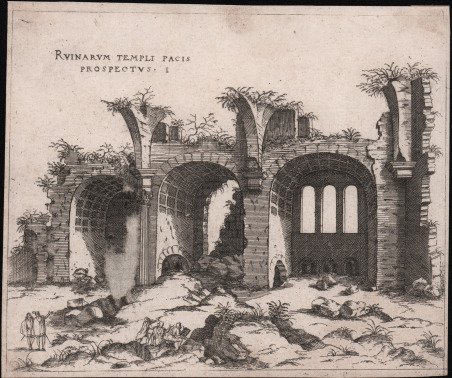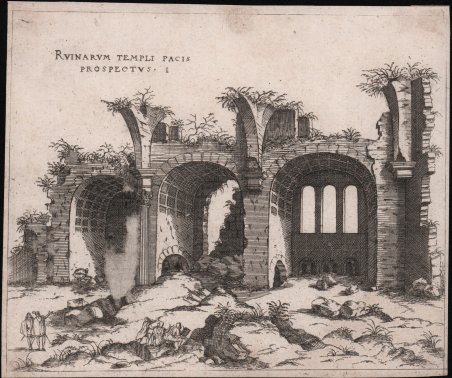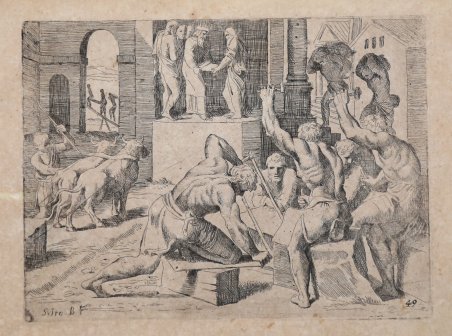Acquaforte, 1555 circa, priva di indicazioni editoriali. Opera appartenente alla rarissima serie Praecipua aliquot Romanae antiquitatis ruinarum monimenta vivis prospectibus ad veri imitationem affabre designate, attribuita alla mano di Jacques Androuet Du Cerceau. Si tratta di una serie di incisioni basate sull’omonima opera di Hieronimus Cock, stampata ad Anversa nel 1551 (frontespizio e 24 tavole). Tutte le rovine sono sinonimo di persistenza e decadenza. Eppure la specificità delle rovine romane, per l'editore di Anversa Hieronymus Cock (c. 1510-1570), risiede meno in una sublimità carica che in un persistente potere di modellare, di fornire modelli nel suo qui-e-ora olandese. La sorprendente serie di incisioni di Cock, i Praecipua Aliquot Romanae Monimenta fu pubblicata nel 1551. Uno dei primi prodotti della rivoluzionaria ditta Aux Quatre Vents di Cock, la Praecipua si è a lungo dimostrata problematica per gli storici dell'arte, poiché non sembra tanto documentare l'antica Roma quanto presentare la città come un paesaggio, una distesa di strutture disastrate. Scrivendo nel 1907, l'archeologo Hülsen si lamentava che le vedute di Cock "non ci insegnano quasi nulla" dell'antichità, e "descrivono solo quanto grave sia diventato lo sttao id conservazione dei monumenti". Eppure il fascino cinquecentesco delle stampe di Cock risiedeva proprio in questa rappresentazione della decadenza. Per il suo pubblico Cock frammentava le vedute del Colosseo, confondeva le distanze tra edifici come il Settizonio e le Terme di Diocleziano e corredava le rovine con piccoli animali e figure umane. In definitiva, le incisioni non erano importanti come documenti antiquari, ma come stampe di modelli, che vennero riutilizzati ed estrapolati da intarsisti tedeschi, fabbri olandesi e pittori italiani. Era il mezzo di stampa che permetteva a tali copie di ricostruire una Roma che non c'era più, non tanto mostrandola quanto rimettendola in scena attraverso una sorta di virtualità antiquaria. (cfr. Christopher P. Heuer, Hieronymus Cock's Aesthetic of Collapse, pp. 387, 389-408, Oxford 2009). La serie del Du Cerceau è una fedele riduzione delle incisioni di Cock. Si dovrebbe comporre di 24 tavole, ma la sua estrema rarità - non ci risultano esemplari completi della raccolta, ma solo pochissime piccole collezioni delle tavole (13 tavole, incluso il frontespizio, sono conservati a Roma, BIASA [Rari I 93]) – non permette di stabilirlo con certezza. Bellissima prova, impressa su carta vergata coeva, rifilata al rame, foro di tarlo nella parte inferior, per il resto in perfetto stato di conservazione. Rarissima Bibliografia Per Du Cerceau: Inventaire du fonds français 1932, v. I, p. 53; Les Du Cerceau, leur vie et leur oeuvre, d'après de nouvelles recherches par le baron Henry de Geymüller (1887); Jean Guillaume, Peter Fuhring Jacques Androuet du Cerceau: un des plus grands architectes qui se soient jamais trouvés en France, Parigi, 2010. Per Hieronymus Cock: H. Coch, The Reinassance in Print, pp. 90-103; Christopher P. Heuer, Hieronymus Cock's Aesthetic of Collapse, pp. 387, 389-408. Etching, circa 1555, lacking editorial indications. Work belonging to the exceedingly rare series Praecipua aliquot Romanae antiquitatis ruinarum monimenta vivis prospectibus ad veri imitationem affabre designate, attributed to the hand of Jacques Androuet Du Cerceau. This is a series of engravings based on the work of the same name by Hieronimus Cock, printed in Antwerp in 1551 (frontispiece and 24 plates). “All ruins bespeak both persistence and decay. Yet the specificity of Roman ruins, for the Antwerp publisher Hieronymus Cock (c. 1510—1570), lay less in a charged sublimnity than in a lingering power to model, to furnish templates in his Netherlandish here-and-now. Cock's astonishing series of etchings, the Praecipua Aliquot Romanae Monimenta was published in 1551. One of the earliest products of Cock's revolutionary Aux Quatre Vents firm, the Praecipua has long proven problematic to art historians, since it seems less to document ancient Rome than to present the city as landscape, a sprawl of disabled structures. Writing in 1907, for example, the archaeologist Hülsen complained that Cock's views 'teach us nearly nothing' of antiquity, and 'depict only how grave the monuments' "en-rubblement" (Verschüttung) has become'. Yet the sixteenth-century appeal of Cock's prints lay precisely with this enactment of decay. For his audiences Cock fragmented views of the Colosseum, blurred distances between buildings like the Septizodium and the Baths of Diocletian and dotted the ruins with tiny animals and human figures. Ultimately, the etchings mattered not as antiquarian documents but as pattern prints, templates re-used and excerpted by German intarsists, Dutch metalsmiths, and Italian painters. It was the print medium that enabled such copia to reconstruct a Rome that was no longer there, less by showing it than re-staging via a kind of antiquarian virtuality, its aesthetic of bricolage” (cf. Christopher P. Heuer, Hieronymus Cock's Aesthetic of Collapse, pp. 387, 389-408, Oxford 2009). The Du Cerceau series is a faithful reduction of Cock's engravings. It should consist of 24 plates, but its extreme rarity - there are no complete set of the collection, but only very few small collections of the plates (13 plates, including the frontispiece, are preserved in Rome, BIASA [Rari I 93]) - does not allow us to establish this with certainty. Beautiful proof, printed on contemporary laid paper, trimmed to the platemark, woodworm hole in lower part, otherwise in perfect condition. Exceedingly rare. Literature Inventaire du fonds français 1932, v. I, p. 53; Les Du Cerceau, leur vie et leur oeuvre, d'après de nouvelles recherches par le baron Henry de Geymüller (1887); Jean Guillaume, Peter Fuhring Jacques Androuet du Cerceau: un des plus grands architectes qui se soient jamais trouvés en France, Parigi, 2010; H. Coch, The Reinassance in Print, pp. 90-103; Christopher P. Heuer, Hieronymus Cock's Aesthetic of Collapse, pp. 387, 389-408. Cfr.



Découvrez comment utiliser
Découvrez comment utiliser

